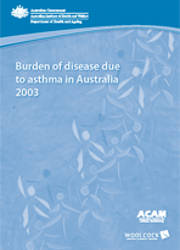Summary
Asthma affects people of all ages and is associated with a substantial impact on both the individual and on the community. Most of the impact of asthma is on physical functioning and on the ability to perform social roles. This report provides information on the burden of asthma in Australia by summarising the asthma-related findings of two reports: The burden of disease and injury in Australia 2003 and The burden of disease and injury in Aboriginal and Torres Strait Islander peoples 2003.
How is burden of disease measured?
While there are several ways to estimate the burden of disease, we report here on an approach adopted by the World Health Organization and many individual nations, including Australia. Disability-adjusted life years or 'DALYs' have been used in this report to quantify the burden of asthma. The DALY describes the number of years of healthy life lost due to disability or premature death. One DALY represents one lost year of healthy life.
What is the burden of asthma in Australia?
In 2003, asthma was the eleventh-leading contributor to the overall burden of disease in Australia, accounting for 2.4% of the total number of DALYs. In that year, 63,100 years of healthy life were lost due to asthma-59,054 of these due to years lived with disability and 4,045 due to premature death.
This report highlights the relative importance of long-term disability among children as a contributor to the burden of asthma in Australia. Among children, asthma represented the leading cause of burden of disease in 2003, contributing 17.4% of total DALYs.
It is predicted that asthma will continue to rank as one of the major causes of disease burden in Australia for the next 2 decades, particularly among females.
Chronic respiratory disease, which includes asthma, was the fourth-leading contributor to the Indigenous health gap in the burden of non-communicable conditions. It accounted for 9% of the gap, behind cardiovascular disease (23%), diabetes (12%) and mental disorders (12%).
How can we use this information?
Quantifying the impact of asthma in terms of its burden, measured as DALYs, allows relative valuation of the impact of this disease-both overall and in subgroups of society-relative to other diseases. This has important consequences for health decision-making and planning processes. This report provides an indication of opportunities for health gain and will help guide the formation of health policy in relation to asthma. For example, interventions to reduce the Indigenous health gap in chronic respiratory disease burden and to improve the uptake of the key elements of effective asthma management-namely, a written asthma action plan and regular use of medications that control the disease and prevent exacerbations-represent two strategies likely to lead to reduced burden of disease attributable to asthma.



